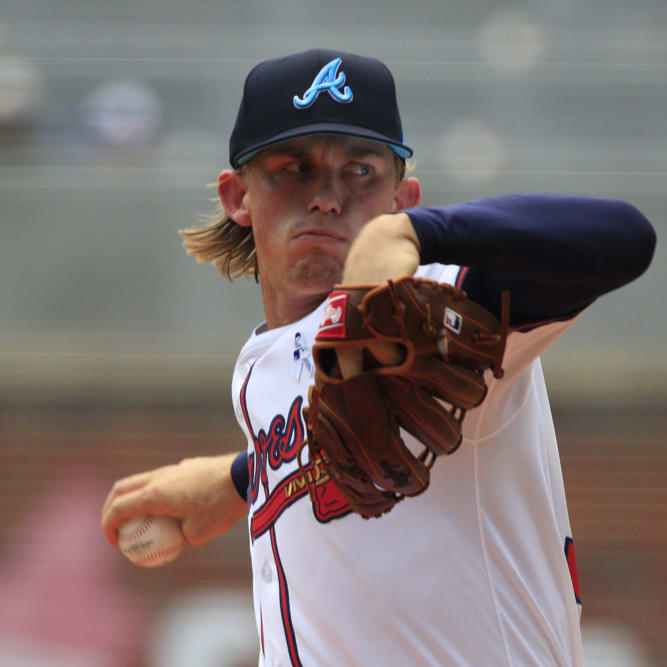We're now two months deep into the season, and it's maybe been easy to get lost in the weeds of FAAB bids, roster moves, standings checks and trade offers and miss the bigger picture of what's actually been happening this season. Here's a list that might help hammer it home:
Eloy Jimenez, Pete Alonso, Fernando Tatis Jr., Chris Paddack, Cole Tucker, Michael Chavis, Bryan Reynolds, Vladimir Guerrero Jr., Griffin Canning, Nick Senzel, Corbin Martin, Nicky Lopez, Oscar Mercado, Keston Hiura, Austin Riley, Brendan Rodgers, Cavan Biggio.
That's 17 top prospects in eight-plus weeks that have made their MLB debuts in 2019. It's far from an exhaustive list. Not included are elite names who made their debuts late in 2018 and are now in their first full seasons, like Victor Robles. It doesn't include players like Nate Lowe or Carter Kieboom, who made their debuts this year but then got sent back down – and who will probably be back again before long. It doesn't include players like Bo Bichette or Jesus Luzardo, who likely would have been up already if not for injury. And it doesn't include less heralded callups like Trent Thornton or Harold Ramirez, who are currently among the rookie WAR leaders and might go on to have productive careers despite their lack of pedigree – there are always a couple of guys like that every year.
We're now two months deep into the season, and it's maybe been easy to get lost in the weeds of FAAB bids, roster moves, standings checks and trade offers and miss the bigger picture of what's actually been happening this season. Here's a list that might help hammer it home:
Eloy Jimenez, Pete Alonso, Fernando Tatis Jr., Chris Paddack, Cole Tucker, Michael Chavis, Bryan Reynolds, Vladimir Guerrero Jr., Griffin Canning, Nick Senzel, Corbin Martin, Nicky Lopez, Oscar Mercado, Keston Hiura, Austin Riley, Brendan Rodgers, Cavan Biggio.
That's 17 top prospects in eight-plus weeks that have made their MLB debuts in 2019. It's far from an exhaustive list. Not included are elite names who made their debuts late in 2018 and are now in their first full seasons, like Victor Robles. It doesn't include players like Nate Lowe or Carter Kieboom, who made their debuts this year but then got sent back down – and who will probably be back again before long. It doesn't include players like Bo Bichette or Jesus Luzardo, who likely would have been up already if not for injury. And it doesn't include less heralded callups like Trent Thornton or Harold Ramirez, who are currently among the rookie WAR leaders and might go on to have productive careers despite their lack of pedigree – there are always a couple of guys like that every year.
It also conspicuously doesn't include the Houston duo of Yordan Alvarez and Kyle Tucker, who continue to cool their heels at Triple-A because of reasons.
Back in the spring, the discussion in prospect circles was dominated by Guerrero's case, and criticisms of organizations trying to play games with service time by delaying promotions to secure an extra year of control before their young talent became eligible for free agency. That's all been basically forgotten, as some time between then and now, teams apparently decided to heck with it -- let's just call everybody up.
What is going on? And how can a savvy GM in a keeper or dynasty league profit from it?
Winter 2021 is Coming
(C'mon, you didn't think bad Game of Thrones-inspired headlines would go away just because the show ended, did you?
The most logical explanation for front offices opening the floodgates on their prospect pipelines is that they don't expect the current rules for contracts and service time to still exist by the time this crop of kids would have been eligible for free agency. The current CBA is set to expire at the beginning of December 2021, and while there's no telling how negotiations will go, it seems almost certain that the MLBPA will be looking to close or restrict the service-time loopholes that teams have used since Kris Bryant's debut to buy that extra year of team control.
Basically, what we're seeing happen this year is what should have been happening all along – organizations are promoting kids because they think they're ready to contribute wins, without worrying about what kind of salary bump they'll be getting six years down the road. That's... well, that's really good, actually. This is the baseball world as it always should have been, a world where being one of the 25 best players in your organization meant you got to play in the majors, not one where that came with all kinds of accounting asterisks aimed at reducing costs in the indeterminate future.
If anything, the old system may have been creating a promotion bottleneck that's finally cleared this season. How many of the prospects on that list above would have made their debuts in 2018 alongside Robles, if their clubs hadn't been focused on pinching future pennies instead of the won/lost column?
If that is the scenario we're looking at, it means there will be a three-season window which could well be a golden era for young talent. Sure, a lot of prospects have already gotten called up, but the spigot isn't about to be shut off. Aside from the Astros' jealously hoarded clutch of future studs and players like Kieboom getting ready for round two in their careers, our Top 400 prospect lists features high-ceiling guys like Jo Adell, Alex Kirilloff, and the rapidly rising Brendan McKay in premium spots. Teenagers like Wander Franco and Royce Lewis could flip the switch and make quick ascents at any time. The Tigers have two potential aces in Casey Mize and Matt Manning currently tormenting Eastern League hitters. Etc etc. With service time no longer a priority, would it really be shocking to see any of those players, or a host of others like them, in the majors and making an impact at some point over the next four months?
Breaking the Wheel
Under the principles which it seemed like MLB organizations used to operate, rebuilding your franchise in a dynasty league was a multi-year affair. You dealt older talent for the best prospects you could, let them crawl through the minors for a few years, and hoped enough of them panned out that you would have a competitive core. Keeper-style leagues had shorter rebuild windows, as contracts expired and endgame auction bargains got raises or returned to the player pool, but identifying which prospects synced up better with your target date for being a title contender was still an important part of the process.
If those principles no longer apply, though, all bets are off. Somewhere out there are "rebuilding" teams that started the season with some significant combination of Jimenez, Guerrero, Tatis, Alonso, Senzel, Paddack, Canning, Chavis, Riley etc. in their system and have been catapulted into competitiveness earlier than expected, and who are now faced with the dilemma of whether to trade the assets that haven't hit the majors yet for more immediate production.
The old idea of a "success cycle" might actually be broken, at least for the time being. If you no longer need to wait years for a top prospect investment to mature – if a player in the low minors might end up being 18 months away from his debut instead of 38 – then the short-term value needed to acquire them should spike. It's one thing to trade a kid expecting that it'll be a couple of years before you might regret it. It's another to trade a kid and have it come back to haunt you before the end of the current season – ask someone who traded McKay for immediate pitching help back in April how they're feeling now that he's already dominating Triple-A hitters. As the time you have to recoup their future value shrinks, the raw amount of present-day value you need to get back to make the deal worthwhile grows. At a certain point, it might not even make sense to trade those prospects at all – and in either case, it means fewer future assets headed to teams trying to rebuild, making it that much tougher to pull off.
The old system was essentially like the ocean. Talent flowed back and forth from roster to roster, pooling in different areas of the rocky coast from one year to the next, and hopefully you could pull in a title when high tide hit your private beach. If that flow stops or gets significantly muted, though, the best course of action might be instead to get away from that boom-bust cycle and maintain a safe floor of production from year to year, more like a bathtub – with the water level rising when your own prospects mature and get dropped into the water.
Viewed from another perspective, if prospects are spending less time in minor-league systems, it means you'll be churning through them quicker, whether you trade them or keep them. That means more opportunities to grab pop-up and breakout performers and take chances on unproven, high-upside kids before they break out, and less incentive to fill up slots with low-upside players who seem closer to the majors. In deep leagues, it sometimes made sense to grab a minor-leaguer who maybe only projected to be a back-end starting pitcher or platoon outfield option, as getting that short-term production might prove more valuable than stashing some wet-behind-the-ears teenager who hadn't yet seen full-season ball, and who might not pull in much in a trade. The reasons to take that approach are now fading.
Of course, the 2022 season – the first under the new CBA, unless the two sides cut a deal early – will be here sooner than you think, and the environment could change radically once again. Clubs might find all new incentives to keep their best prospects in the minors rather than letting them contribute in the majors, and the wheel might begin to grind once again. Until then, though, it might be a good idea to break free of that success cycle you've been chained to and consider setting a new path for yourself, before you end up lying in the rubble of your broken championship dreams like Dany. Poor, poor Dany.

































